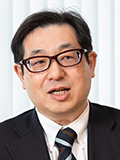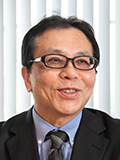 The status of regenerative medicine has been changed significantly these years, here we have many companies entering into this field of business who are new entries. It seems there exist huge expectation for regenerative medicine as a 'Business Opportunity' in Japan.
The status of regenerative medicine has been changed significantly these years, here we have many companies entering into this field of business who are new entries. It seems there exist huge expectation for regenerative medicine as a 'Business Opportunity' in Japan.
The Japanese government targets regenerative medicine as one of Japan's growth strategies. They promote the commercialization by preparing regulations, for instance, introducing 'Conditional and Time-limited Authorization'. Although these days trends, the commercialization for regenerative medicine is still far away.
Hiroyuki Kano from the Forum for Innovative Regenerative Medicine (FIRM) and Ryuji Hiramatsu from the Foundation for Biomedical Research and Innovation at Kobe (FBRI) talked about the actual status and the bottleneck issue of regenerative medicine.
The new regulation has greatly accelerated the development of this industry.
―― To start, could you introduce yourself with your academic background and working career?
Kano: I majored in microbiology at the Faculty of Pharmacy both at university and graduate school. After graduation, I have spent 28 years in research and development division for new drugs at Astelas pharma Inc.. After cooperated with JPMA, KEIDANREN (Japan Business Federation) and other organizations, I am being assigned to FIRM since 2018 April.
Hiramatsu: I majored in the engineering department at university. At the graduate school I switched to genetic engineering in the agricultural department. After graduation I got a job at a pharmaceutical company. Thereafter I did research on the mechanisms of antibody gene rearrangement as a postdoctoral researcher at the University of California, Berkeley. After returning to Japan, I worked at a research institute and moved to the current position at FBRI in 2013.
―― Would you describe the very first step to get involved in regenerative medicine?
Hiramatsu: It all started my career in the regenerative medicine project as a researcher at Sumitomo Dainippon Pharma. Actually, I have had done research with Dr. Shinya Yamanaka on embryonic stem cells before that. Dr. Yamanaka and I were both enrolled in the University of California, I was at Berkeley and he was at San Francisco, so we have interaction since then.
Kano: While working for the pharmaceutical company, I was mainly involved in the research and development of low molecular weight compounds and some research has concept close to regenerative medicine. For example, 20 years ago, the Treatment for Fractures by promoting Osteoblast Differentiation was done using low molecular weight compounds. It could be done by another point of view these days. However, it was after then I was sent on loan to FIRM where I was really involved in regenerative medicine.
――In recent years, the Current situation of regenerative medicine has been changed significantly. Would you describe the current situation of each organization?
Kano: In 2011, at the time FIRM was established, the number of memberships was only 14. At present, it exceeded 250 in 8 years, and still expanding. Looking at our membership backgrounds, nearly 60% companies are equipment manufacturing distributors or material suppliers, about 20% are pharmaceutical companies and the remaining 20% are from newly involved industries, such as chemical manufacturers.
Hiramatsu: The Kobe Biomedical Innovation Cluster (and FBRI), was established as part of the reconstruction project for Kobe City, Hyogo Prefecture, which was severely damaged by the Great Hanshin-Awaji Earthquake (1995). The aim was to ' Construct the very first Bio Cluster in Japan'. At present, we have more than 350 companies and organizations to cooperate with. The quarter of those are involved in regenerative medicine and drug discovery.
――A large number of companies participate in both organization. May I recognize this as the regenerative medicine industry extend to diverse field?
Kano: Exactly. That is why so many companies have participated in the organization. In the regenerative medicine field, it is not possible for companies except so-called Mega Pharmacy to deal with everything from upstream basic research to downstream product distribution only by themselves. Currently, most of the companies concerned regenerative medicine collaborate with external companies and organizations, in development assignment and manufacturing assignment, for product developing.
――It seems that the regulatory system is being developed recently, for example, establishment of 'Conditional and Time-limited Approval'. Could you state your opinion?
Hiramatsu: I consider 'Conditional and Time-limited Approval' has contributed to accelerate the development in regenerative medicine products. Moreover, introducing 'SAKIGAKE Designation System*' made good relationship between companies and regulatory authorities. The aim of 'SAKIGAKE' is the early realization of innovative products. As a result, both systems have greatly accelerated the development of regenerative medicine in Japan.
*Promote R&D in Japan aiming at early practical application for innovative pharmaceutical products, medical devices, and regenerative medicines
Kano: There have been 11 products subject to 'SAKIGAKE ' thus far, two of them were submitted by overseas companies. This fact shows there exist a trend in foreign-affiliated companies taking advantage of 'SAKIGAKE' system, 'Start one's business in Japan by submitting application for approval and sales'. Therefore, it is important to utilize the systems properly hereafter.

Hiroyuki Kanoh(Forum for Innovative Regenerative Medicine)
'Harmonization in Regulation' is the issue in regenerative medicine. The first step is Asia.
――How do you think what is the current issue?
Kano: One of the current problems is regulation. For example, the regulation for validation of effectiveness has not yet been sufficiently organized, while the regulation for safety validation has been improved. There is a great amount of things to settle, such as how to collect data and what kind of data is needed when using the post-marketing surveillance, after 'Conditional and Time-limited Approval',. Industry, academia and government ought to collaborate together to find effective ways in regulation.
Hiramatsu: Globalization is also a problem in regulation. The strategy focusing on only the Japanese market may cause limited growth, and this does not restricted in regenerative medicine. The products get the approval for manufacture and sales in Japan shall be approved in other countries without difficulties. 'Harmonization of Regulation for Regenerative Medicine' is necessary to enable this procedure.
Kano: Certainly, it is very important. Our aim is 'Harmonization of Regulation' through 'Asia Partnership Conference of Regenerative Medicine Associations', constituted of organizations and regulators in Asia which is engaged in regenerative medicine. I believe our efforts will lead to the realization of 'Universal Health Coverage (ensuring that all people have access to needed health services of sufficient quality to be effective while also ensuring that the use of these services does not expose the user the financial hardship.)' in the future.
――At present, there is a tendency for regenerative medicine products to be expensive. How could we resolve this issue?
Hiramatsu: It could be said that there remains manual procedure in manufacturing current regenerative medicine products and this led to high cost. Developing a mass production model as low molecular weight compounds, or efficient cell manufacturing may achieve low prices.
Kano: The reduction depends on the cell what you handle, autologous or allogeneic. It is possible to culture allogeneic cells in large quantities, thus we can discuss cost reduction issue.
Hiramatsu: Certainly. Although allogeneic cells are accompanied by problems of the attribution of rights, at present, cell producers can acquire the rights to manufacture. That is because iPS cells and ES cells are produced in large quantities by obtaining cells from national institutions that could be used industrially. However, the technique for efficient use of allogeneic cells involves ethical issues, we should solve the problem in future.
Kano: One of the possible solutions is developing cell banks anticipated commercial use. Although this cannot be developed only by private companies or academia, it would be important to cooperate with government agencies to promote the preparation of the system.

Ryuji Hiramatsu(Foundation for Biomedical Research and Innovation at Kobe)
Achieve 'Industrialization of Regenerative Medicine by working together through all-Japan effort.
――Would you tell me your future prospects?
Kano: Our mission is 'Industrialization of Regenerative Medicine'. There are some products which have already been launched, but most businesses seem to be in red. Hence, I cannot say that industrialization has succeeded. We announced that we implemented the industrialization of regenerative medicine to popularize innovative treatments in the FIRM VISION 2025 announced in June, 2019. One of the priority issues is 'implementation of appropriate regulation for regenerative medicine'. We will work on solving these issues.
Hiramatsu: University researchers and industries from overseas often point out that 'There is no Hotspot in Japan where innovation in biotechnology can be expected'. I feel very sad to hear such comments as I am concerned. Therefore, we plan to foster young entrepreneurs in bio-industry and develop new industries. We hope to eventually make Kobe City into a biomedical hotspot comparable to Boston and San Francisco.
――What do you expect in LINK-J?
Kano: LINK-J offers occasion to meet a variety of players, such as people from industries and university researchers both from Japan and overseas. I hope we can maintain a cooperative relationship, so that we all can handle several things together in a larger framework.
Hiramatsu: There must be issues that we three can take on together especially in the industrialization of regenerative medicine. We want to challenge them the world by collaborating through 'All-Japan effort', let all bio-clusters in Japan become close by opening their hearts.

 Hiroyuki Kanoh
Hiroyuki Kanoh Graduated from the master's course, Nagoya City University Graduate School. After graduation, he joined Yamanouchi Pharmaceutical Co., Ltd. (currently: Astellas Pharma Inc.) and was engaged in bone and cartilage metabolism research and global clinical development of a drug for renal disease as well as in launching of osteoporosis and hyperphosphatemia treatments. Recently, he has been in the External Relations department to be engaged in industry activities. In 2018, he was dispatched from Astellas Pharma Inc. to the Forum for Innovative Regenerative Medicine and currently acts as the Secretary General.
 Ryuji Hiramatsu
Ryuji Hiramatsu Graduated from Osaka University, School of Engineering, and the University of Tokyo, Graduate School of Agriculture. After graduation, he joined Green Cross Corporation. Subsequently, he worked with Professor Hitoshi Sakano at the University of California at Berkeley to study the reconstitution mechanism of antibody genes. After returning to Japan, he joined Sumitomo Chemical Biotechnology Research Center or Sumitomo Pharma, and Sumitomo Dainippon Pharma (at that time) due to the subsequent reorganization. He was engaged in research on regenerative medicine using iPS cells and other works. He has worked for the Foundation for Biomedical Research and Innovation at Kobe since 2013.